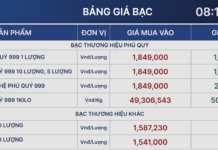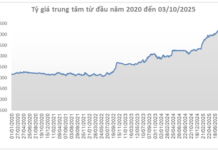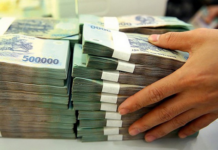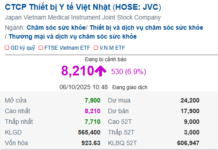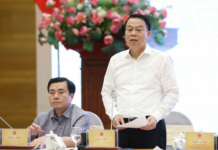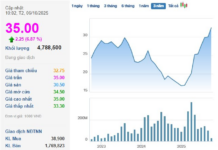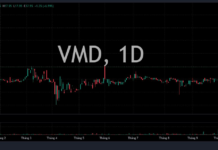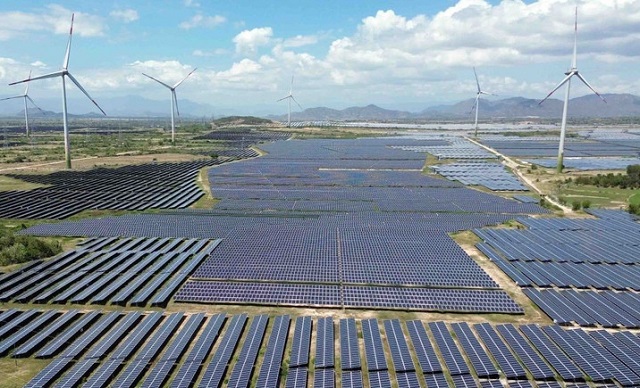
Wind and solar energy projects in Bac Phong, Thuan Bac District, Ninh Thuan Province. (Photo: Tran Viet/ VNA)
|
With financial demands for Vietnam’s energy transition potentially surpassing $135 billion in the 2021-2030 period, according to the World Bank, addressing investment and financial framework bottlenecks becomes crucial to accelerating this green transformation.
Challenges in Energy Finance Mobilization
Dr. Ngo Tri Long, an economic expert, points out that one of the biggest hurdles in mobilizing financial resources for Vietnam’s energy transition is the electricity pricing mechanism, which does not accurately reflect investment costs, risk levels, and expected profits for private investors, particularly strategic investors and international financial institutions.
Specifically, the mechanism for determining price ceilings in the bidding process for renewable energy projects, including solar and wind power, relies primarily on domestic calculation frameworks. It fails to adequately consider financial risks, borrowing costs, and currency risk mitigation expenses typically faced by foreign investors.
Additionally, the lack of long-term enforceability and risk guarantees in power purchase agreements (PPAs) means that renewable energy projects in Vietnam cannot attain an acceptable credit rating for disbursement.
Consequently, only 15% of renewable energy projects in Vietnam can access long-term foreign currency loans from international financial institutions, mostly thanks to guarantees from development funds (as per the ADB report in 2024). In contrast, most other projects have to rely on domestic currency loans with interest rates higher by 3-5 percentage points. Moreover, the ability to attract international green finance is constrained and lags significantly behind other regional countries like Thailand and Indonesia.
The second challenge lies in the absence of a comprehensive and centralized legal framework for green finance. This includes a lack of legislation on carbon markets and emissions pricing, dispersed regulations on green bonds that do not strongly encourage issuers, resulting in a meager 0.1% of the total value of corporate bond market issuances being green bonds from 2019 to 2024 (as per the ADB report in 2024), compared to 5-6% in other ASEAN countries like Thailand, Malaysia, and Singapore.
Furthermore, the mechanism for renewable energy certificates (RECs) lacks clarity, and the absence of a synchronized legal framework prevents many Vietnamese businesses from accessing substantial international concessional funds, such as the Green Climate Fund (GCF) and the Sustainable Development Goal Fund (SDG Fund), as well as hybrid financial models.
The third challenge is the gap in state capital steering through capable public financial institutions, similar to the successful “Green Reconstruction Bank” model implemented in countries like Germany, South Korea, and the United Kingdom.
Meanwhile, establishing a “Green Development Bank” is a strategic move to mitigate investment risks for the private sector, unlock international capital, enhance public capital efficiency, and ensure progress toward realizing the net-zero emissions commitment by 2050, as suggested by expert Ngo Tri Long.
Piloting the National Energy Bank Model
At the recent 2025 Annual Oil and Energy Forum organized by the Vietnam Oil and Gas Association, delegates proposed legalizing green finance, standardizing investment norms for new technologies, and designing flexible power purchase agreements based on regions, technologies, and scales. They emphasized the need for reference prices close to reality and clear offtake mechanisms for key projects. Additionally, they recommended strengthening the state’s coordinating role through public financial institutions and risk guarantee mechanisms for new energy projects.
To address financial bottlenecks, Mr. Nguyen Duc Hien, Deputy Head of the Central Committee on Policy and Strategy, suggested attracting private sector investment in energy transition projects through public-private partnerships. Currently, the total green transition funding from the banking system stands at a meager 4.36%, underscoring the need for a specialized institution.
Mr. Hien pointed out that continuing with the current approach would be challenging due to the centrality of interest alignment in attracting private investment. He also emphasized the necessity of reforming the electricity market, the power purchase mechanism, and resolving lingering issues in wholesale and retail electricity sectors.
From a business perspective, a representative of Binh Son Refining and Petrochemical Company proposed developing and perfecting a stable and long-term legal framework for critical and emerging sectors in the energy transition. These sectors include carbon capture, utilization, and storage (CCUS) technology, carbon credits, sustainable aviation fuel (SAF), and next-generation biofuels.
Additionally, the company representative advocated for green credit policies to incentivize investments in clean technologies and carbon recycling, along with tax exemption mechanisms for green and environmentally friendly products to encourage businesses to invest in green projects.
Meanwhile, economic expert Ngo Tri Long proposed piloting the National Energy Bank model in the context of Vietnam’s rapidly growing investment demands for its energy transition. He suggested that Vietnam’s state-owned industrial and energy conglomerate, Petrovietnam, could co-found the National Energy Bank, in collaboration with major commercial banks like BIDV, Agribank, and Vietcombank, under the auspices of the Ministry of Finance and the State Bank.
This National Energy Bank would focus on providing medium- to long-term credit (15-25 years) for renewable energy, energy storage, green hydrogen, and offshore wind projects. It would work in tandem with the Petrovietnam Energy Transition Fund to create a hybrid finance ecosystem that supports technological innovation. The bank could issue green bonds to attract international capital at preferential interest rates and tap into domestic and foreign carbon market mechanisms.
Additionally, it could redistribute funds to startups and small investors who struggle to access traditional commercial loans, especially in rural and island areas. The state could share risks through a risk guarantee fund for energy investments, modeled after the European Union’s Green Guarantee Facility (GGF). Such an institution would help steer Vietnam’s energy transition and green growth agenda.
International examples of successful green finance institutions include KfW in Germany, which has provided over €80 billion in funding for clean energy projects in Europe, with a financial leverage ratio of 1:5. The Green Bank in the UK mobilized over £15 billion from the private sector in its first five years, mainly through green bonds and public-private partnerships. Indonesia Infrastructure Finance (IIF) is a development bank jointly established by the Indonesian government and the World Bank/ADB, specializing in long-term energy infrastructure financing.
“The Vietnamese Energy Bank model can draw insights from these institutions but must be localized, combining the state’s coordinating role, Petrovietnam’s technical capabilities, and market forces,” suggested Mr. Long.
Anh Nguyen
– 09:26 19/08/2025

